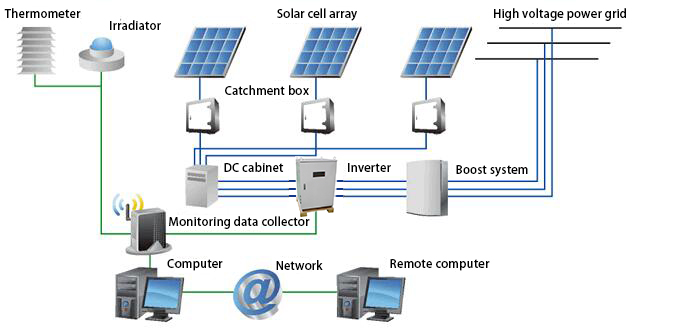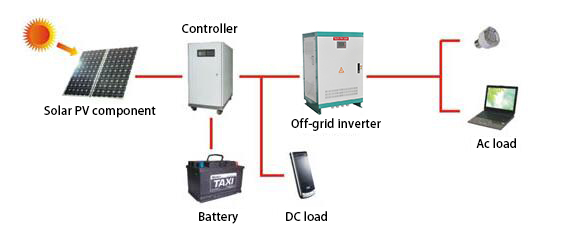In the realm of renewable energy and sustainable power solutions, inverters play a pivotal role in converting direct current (DC) generated by solar panels or wind turbines into alternating current (AC) for use in homes, businesses, and industries.
Two primary types of inverters dominate this landscape: on-grid inverters and off-grid inverters. Each serves distinct purposes and operates within different contexts. Inverter.com will introduce on-grid inverters and off-grid inverters, and discuss the working principles of off-grid inverters and on-grid inverters, as well as their differences.
Inverter basics:
An inverter refers to a device that converts DC power (such as a storage battery) into AC power (usually 220V, 50Hz sine wave). It is composed of an inverter bridge, control logic, and filter circuit. Inverters are widely used in air conditioners, home theaters, electric grinding wheels, electric tools, sewing machines, DVDs, VCDs, computers, TVs, washing machines, range hoods, refrigerators, video recorders, massagers, fans, lighting, and other fields. When working or traveling, the inverter can be connected to the battery to drive the electrical appliances and various tools to work. By the cigarette lighter, a car power inverter outputs continuous power of 40W, 75W, 120W, 150W to 300W. The more powerful inverter power supply should be connected to the battery through the connecting wire. Various electrical appliances can be used in the car by connecting household appliances to the output of the power converter.
On-grid inverter basics:
On-grid inverters are also called grid tie inverters, which are generally divided into solar PV power generation grid tie solar inverters, wind power generation grid tie inverters, power equipment generation grid tie inverters, and other equipment generation grid tie inverters. The biggest advantage of a grid-connected inverter is the high system power and low cost.

Grid tie inverters are generally used in the system of large-scale solar photovoltaic power stations. Many parallel photovoltaic strings are connected to the DC input of the same centralized inverter. Generally, three-phase IGBT power modules are used for higher power, and field effect transistors are used for lower power. At the same time, it uses a DSP conversion controller to improve the quality of the generated power, making it very close to a sine wave current.
Key features of on-grid inverters include:
- Grid Synchronization: Grid-connected inverters are equipped with advanced synchronization mechanisms that enable them to match the phase and frequency of the utility grid. This synchronization ensures smooth power flow between the renewable energy system and the grid.
- No Battery Storage: Unlike off-grid solar inverters, on-grid tie inverters do not require battery storage systems. They rely solely on the utility grid for power regulation and stability. This characteristic simplifies the installation and reduces the overall cost of the renewable energy system.
- High Efficiency: Grid tie inverters are optimized for high efficiency and performance under grid-connected conditions. They minimize power losses during the conversion process, ensuring maximum utilization of renewable energy resources.
Off-grid inverter basics:
The off-grid PV inverter can work independently after leaving the grid, which is equivalent to forming an independent small grid. It mainly controls its own voltage and can be regarded as a voltage source. Off-grid inverters can carry loads such as resistance-capacitive and motor-inductive loads. It has fast response, anti-interference, strong adaptability, and practicability, so it is the preferred power product for emergency power supply and outdoor power supply.

Generally, off-grid inverters need to be connected to batteries, because their PV power generation is unstable, and the load is also unstable, requiring batteries to balance energy. When the photovoltaic power generation is greater than the load, the excess energy charges the battery. When the photovoltaic power generation is less than the load, the battery does not provide enough energy.
Key features of off-grid inverters include:
- Battery Compatibility. Stand-alone inverters are compatible with battery storage systems, allowing them to store excess energy generated by renewable sources for later use. Batteries serve as an energy reservoir, supplying power during periods of low renewable energy generation or high electricity demand.
- Island Operation. Off-grid inverters support island operation, meaning they can function autonomously without relying on external power sources. This capability is crucial for off-grid applications where grid connectivity is unavailable or unreliable.
- Voltage and Frequency Regulation. Self-sufficient PV inverters are equipped with voltage and frequency regulation mechanisms to ensure stable and consistent AC power output. These features are essential for maintaining the integrity of electrical appliances and equipment connected to the off-grid system.
- Hybrid Functionality. Some independent power inverters offer hybrid functionality, allowing seamless integration with diesel generators or other backup power sources. This hybridization enhances system reliability and resilience, especially in off-grid installations with variable renewable energy generation.
How does an on-grid inverter work in an off-grid manner?
Sometimes, an on-grid inverter can be used directly as an off-grid inverter.
The grid tie inverter sends energy directly to the grid, so the frequency and phase of the grid must be tracked. It is equivalent to a current source. Of course, there are also some inverters that have low-voltage ride-through capability and can be used for PQ adjustment.
The off-grid inverter is equivalent to building an independent small power grid by itself. It mainly controls its own voltage, but in fact, it is a voltage source.
On-grid tie inverter does not require energy storage, but its energy cannot be controlled. As much energy as photovoltaic generates, it sends as much energy to the grid. Off-grid solar inverters generally require energy storage and do not send energy to the grid, and the grid has no right to interfere.
Comparison and conclusion:
In summary, the primary difference between on-grid and off-grid inverters lies in their operational context and functionality. On-grid solar inverters are tailored for grid-connected renewable energy systems, while off-grid solar inverters, such as the 2000W off-grid solar inverter charger, cater to standalone or off-grid applications with battery storage. While both types of inverters contribute to the adoption of renewable energy and sustainable power solutions, their distinct features and capabilities make them suitable for different scenarios and environments.
Understanding the disparity between on-grid and off-grid inverters is essential for selecting the appropriate technology for specific renewable energy projects. By leveraging the strengths of each type of inverter, stakeholders can optimize the performance, reliability, and cost-effectiveness of renewable energy systems, ultimately advancing the transition towards a cleaner and more sustainable energy future.
